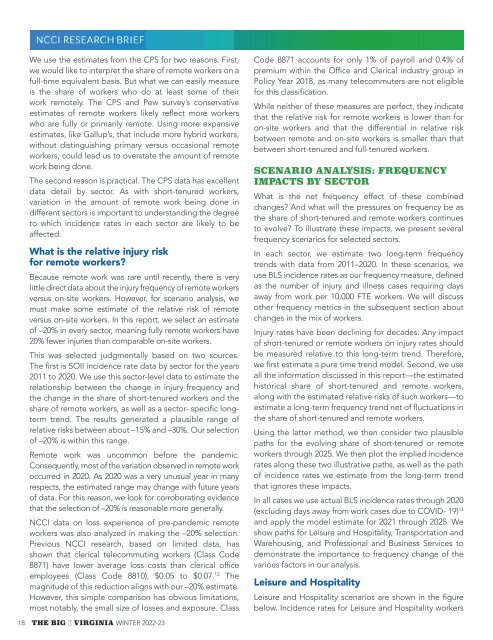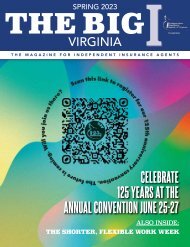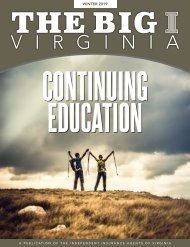The Big I Virginia Winter 2022-23
Create successful ePaper yourself
Turn your PDF publications into a flip-book with our unique Google optimized e-Paper software.
We use the estimates from the CPS for two reasons. First, Code 8871 accounts for only 1% of payroll and 0.4% of<br />
we<br />
Introduction<br />
would like to interpret the share of remote workers on a premium within the Office and Clerical industry group in<br />
full-time equivalent basis. But what we can easily measure Policy Year 2018, as many telecommuters are not eligible<br />
<strong>The</strong> Great Reshuffle is reshaping the US labor market. Unemployment is historically low, but labor force<br />
is the share of workers who do at least some of their for this classification.<br />
work participation remotely. <strong>The</strong> is still CPS lower and than Pew the survey’s pre-pandemic conservative rate. Labor shortages have led to wage growth, especially<br />
While neither of these measures are perfect, they indicate<br />
estimates strong of among remote low-wage workers workers likely reflect and in more sectors workers like Leisure and Hospitality.<br />
that the relative risk for remote workers is lower than for<br />
who are fully or primarily remote. Using more expansive<br />
estimates, Quit rates like jumped Gallup’s, in that the include middle more of 2021 hybrid and workers, remain high on-site at the workers time of and this that writing—about the differential 50 million in relative quits risk a<br />
between remote and on-site workers is smaller than that<br />
without year, distinguishing almost 10 million primary more versus than occasional pre-pandemic remote averages. Many workers are new to their jobs. Some of these<br />
between short-tenured and full-tenured workers.<br />
workers, are moving could lead from us one to overstate similar job the to amount another, of remote but others are changing industries or occupations. At the same<br />
work time, being there done. are a large number of new remote workers. SCENARIO Many people left ANALYSIS: the office at COVID’s FREQUENCY onset; there has<br />
<strong>The</strong> been second a trickle reason back, is practical. representing <strong>The</strong> CPS a data massive has excellent change in the IMPACTS amount of BY remote SECTOR work compared to before the<br />
data pandemic. detail by sector. As with short-tenured workers,<br />
What is the net frequency effect of these combined<br />
variation in the amount of remote work being done in<br />
changes? And what will the pressures on frequency be as<br />
different How do sectors such is large important changes to understanding the labor market the degree impact<br />
the<br />
workers<br />
share<br />
compensation<br />
of short-tenured<br />
injury<br />
and remote<br />
frequency?<br />
workers<br />
<strong>The</strong><br />
continues<br />
magnitude<br />
to which of these incidence impacts rates relies in on each the sector interaction are likely of three to be factors:<br />
evolve? To illustrate these impacts, we present several<br />
affected.<br />
frequency scenarios for selected sectors.<br />
• How much more or less likely are short-tenured or remote workers to be injured than other workers?<br />
What is the relative injury risk<br />
In each sector, we estimate two long-term frequency<br />
for remote • How workers? much has the share of such workers changed?<br />
trends with data from 2011–2020. In these scenarios, we<br />
• How has the sector mix of the workforce changed<br />
Because remote work was rare until recently, there is very use during BLS incidence the pandemic? rates as our frequency measure, defined<br />
little direct data about the injury frequency of remote workers as the number of injury and illness cases requiring days<br />
versus on-site workers. However, for scenario analysis, we away from work per 10,000 FTE workers. We will discuss<br />
must make some estimate of the relative risk of remote other frequency metrics in the subsequent section about<br />
versus on-site workers. In this report, we select an estimate changes in the mix of workers.<br />
of –20% in every sector, meaning fully remote workers have<br />
20% fewer injuries than comparable on-site workers.<br />
This was selected judgmentally based on two sources.<br />
<strong>The</strong> first is SOII incidence rate data by sector for the years<br />
2011 to 2020. We use this sector-level data to estimate the<br />
relationship between the change in injury frequency and<br />
the change in the share of short-tenured workers and the<br />
share of remote workers, as well as a sector- specific longterm<br />
trend. <strong>The</strong> results generated a plausible range of<br />
relative risks between about –15% and –30%. Our selection<br />
of –20% is within this range.<br />
Remote work was uncommon before the pandemic.<br />
Consequently, most of the variation observed in remote work<br />
occurred in 2020. As 2020 was a very unusual year in many<br />
respects, the estimated range may change with future years<br />
of data. For this reason, we look for corroborating evidence<br />
that the selection of –20% is reasonable more generally.<br />
NCCI data on loss experience of pre-pandemic remote<br />
workers was also analyzed in making the –20% selection.<br />
Previous NCCI research, based on limited data, has<br />
shown that clerical telecommuting workers (Class Code<br />
8871) have lower average loss costs than clerical office<br />
employees (Class Code 8810), $0.05 to $0.07. 13 <strong>The</strong><br />
magnitude of this reduction aligns with our –20% estimate.<br />
However, this simple comparison has obvious limitations,<br />
most notably, the small size of losses and exposure. Class<br />
18 THE BIG I VIRGINIA WINTER <strong>2022</strong>-<strong>23</strong><br />
Injury rates have been declining for decades. Any impact<br />
of short-tenured or remote workers on injury rates should<br />
be measured relative to this long-term trend. <strong>The</strong>refore,<br />
we first estimate a pure time trend model. Second, we use<br />
all the information discussed in this report—the estimated<br />
historical share of short-tenured and remote workers,<br />
along with the estimated relative risks of such workers—to<br />
estimate a long-term frequency trend net of fluctuations in<br />
the share of short-tenured and remote workers.<br />
Using the latter method, we then consider two plausible<br />
paths for the evolving share of short-tenured or remote<br />
workers through 2025. We then plot the implied incidence<br />
rates along these two illustrative paths, as well as the path<br />
of incidence rates we estimate from the long-term trend<br />
that ignores these impacts.<br />
In all cases we use actual BLS incidence rates through 2020<br />
(excluding days away from work cases due to COVID- 19) 14<br />
and apply the model estimate for 2021 through 2025. We<br />
show paths for Leisure and Hospitality, Transportation and<br />
Warehousing, and Professional and Business Services to<br />
demonstrate the importance to frequency change of the<br />
various factors in our analysis.<br />
Leisure and Hospitality<br />
Leisure and Hospitality scenarios are shown in the figure<br />
below. Incidence rates for Leisure and Hospitality workers

















